Introduction
Battlefield Cribbage [BFC] is a variation of cribbage that preserves the purity of cribbage while requiring new levels of strategy and skill. The cards are played openly where each player can see the field of play and make strategic moves, like a commander on a battlefield. It is a game that will amaze you with the depth of play leaving less up to luck and more up to strategy.
Object of the Game
Equipment
BFC is played with a cribbage board and a standard deck cards with a joker. Two pegs for each player are used to keep the score. The front peg indicates the current score and the rear peg indicates the previous score. Whenever points are earned the rear peg leap frogs the front peg.
Number of Players
BFC can be played with 2, 3 or 4 players. In 4-player, the players can play either as individuals or in teams. In team play, your partner is the opposite player.
Card Rank and Value
The joker is called the 'Kill Card'. When scoring a hand, the joker kills the hand it is part of by making the value of the hand zero. If the joker becomes the common card all hands are killed!
Setting Up Play
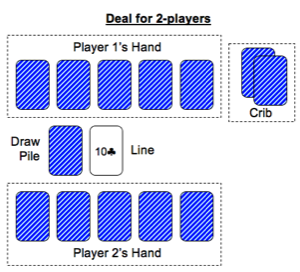
Each player, or team, selects a track on the cribbage board.
The deal is determined by cutting the cards. Low card deals. In subsequent games the dealer is the player who scores the winning point.
The dealer shuffles the cards and allows the player to the right to cut the cards. The dealer will lose his deal if they forget to have the cards cut, but the other players must all agree to have the deal passed to the next player.
Five cards are dealt face down to each player. The five cards becomes the player’s hand. The players are not allowed to look at the cards but rather arrange them face down on the table in front of them. The dealer then places a set number of cards face down in the crib depending on the number of players – 2 cards for 2 players, 1 card for 3 players and no cards for 4 players.
One card is placed face up in the center of the table beginning the line. The unused cards are placed next to the line becoming the draw pile. Throughout play the line will have cards placed on it. The first card placed is termed as the ‘beginning’ of the line, and the last card termed as the ‘end’ of the line.
Playing the Game
The game consists of a series of rounds. The player to the left of the dealer starts and play passes to the left after each round. Scoring occurs during the round (called pegging) for cards played on the discard pile (called the line). Scoring also occurs at the end of each round by scoring each player’s cribbage hand.
At the end of a round each player scores the best 4 out of 5 cards in their hand in conjunction with the common card. This is called ‘scoring a hand’. The card not used in scoring a player’s hand will be placed face up to the crib. Scoring of the hands starts with the person to the left of the dealer, and proceeds to the left. Finally, the dealer scores their own hand and also the crib (see Scoring a Hand). Deal passes to the left of the player who dealt the round.
First Turn of a Round
The first turn of a round begins by the player choosing any two of the cards from their hand to be turned face-up. Now a regular turn is played. This applies for all the players when they get their first turn.
Regular Turn
A regular turn begins by choosing between taking a card from the draw pile or taking the card from end of the line. The turn ends when a card is placed on the end of the line and pegging points are scored (called scoring the line). Scoring the line is described later.
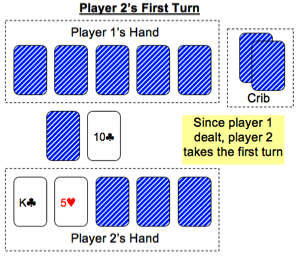
Taking a Card form the Draw Pile
If the player chooses to take a card from the draw pile the player looks at the card and makes a decision to replace a card in their hand or to place the card face up on the end of the line. Any card in the hand may be replaced, whether it is face up or face down. The card is placed face up in the hand. The replaced card is then put face-up on end of the line. If the player does not wish to replace a card in their hand they may place the draw card face-up on end the line. When the card placed on the line causes the sum of the line to exceed 31 points, the player removes the existing cards in the line out of play and places the new card as the beginning of a new line. The player pronounces a ‘go’ and the player to the right scores one point. The line is scored and earned points, if any, are pegged on the board (see Scoring the Line). Play passes to the left.
Taking a Card from the End of the Line
If the player chooses to take a card from the end of the line the player must replace one of the cards from their hand. The card being replaced can be any card, face up or face down. The card from the line is placed face up in the hand. The replaced card is then placed face-up on end the line. When the card placed on the line causes the sum of the line to exceed 31 points, the player removes the existing cards in the line out of play and places the new card as the beginning of a new line. The player pronounces a ‘go’ and the player to the right scores one point. The line is scored and earned points, if any, are pegged on the board (see Scoring the Line). Play passes to the left.
Cease-Fire
At the beginning of a round, if the joker is turned over as the first card in the line the round is dead. The dealer proclaims a 'cease-fire'. The dealer scores one point for last card. Each player scores their hand, starting to the left of the dealer. The exception to scoring is that each player scores all five of cards in their hand. The common card, which is the joker, is not used in the scoring and the crib is not scored.
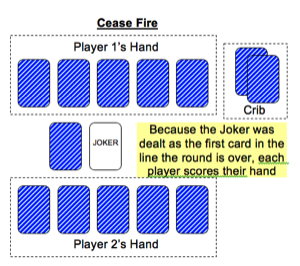
Stand-off
A standoff occurs when players continue to exchange the same cards from their hands with no scoring. Though this is infrequent, when this occurs and no player is willing to break the standoff the dealer must break the stand off by drawing a card from the draw pile during their turn.
Ending the Round
Play continues until one player reveals all five of their hand cards face up, or until there are only two cards left in the draw pile.
Turning Up All Five Face Cards
When a player reveals all five cards in their hand face up during play the player has “gone out”. The remaining players get a final turn. The player to the right of the player who went out will place the final card on the line and this card becomes the common card. The player who places the common card scores one point for playing the last card, unless the sum of the line equals 31. Then the player scores the line. If a jack is laid as the common card the dealer will score two points for Nobs.
Only Two Cards Left on the Draw Pile
The round ends when there are only two cards left in draw pile and the active player does not choose to use the card at the end of the line to place in their hand. In this case, the second to last card on the draw pile is placed face up on the end of the line. This card becomes the common card. This rule applies even if player has gone out. The player who places the common card scores one point for playing the last card, unless the sum of the line equals 31. Then the player scores the line. If a jack is laid as the common card the dealer will score two points for Nobs. The dealer scores the points for Nobs after the current player scores the line.
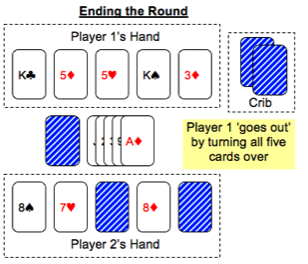
Scoring the Line
Scoring the line is performed at the end of every turn, after the player lays a card on the line. The earned score is equal to the sum total of the points scored for the following items for the cards on the line: the sum of the line value equaling 15 or 31; runs of three cards or more, pairs or combinations of runs and pairs. Use the tables below to determine the score of the line cards

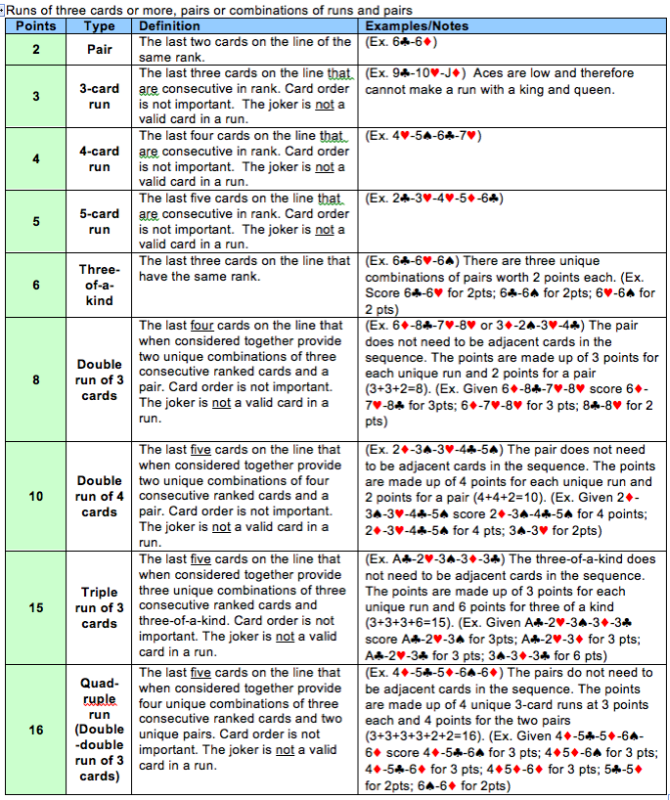
Scoring a Hand
The hand is scored at the end of each round. The player to the left of the dealer scores first and then scoring passes to the left. The dealer scores their hands and the crib.
To score a hand the player turns all their cards face up. Four out of five cards in the hand along with the common card are scored. The card that is not scored from the hand is placed into the dealer’s crib face up. The total number of points the player earns is the sum total of the following four items: the sum of the card combinations equaling 15; a flush; runs, pairs or combinations of runs and pairs; and Nobs. Any hand that has the joker is killed, worth zero points. If the common card is the joker, all hands are killed.
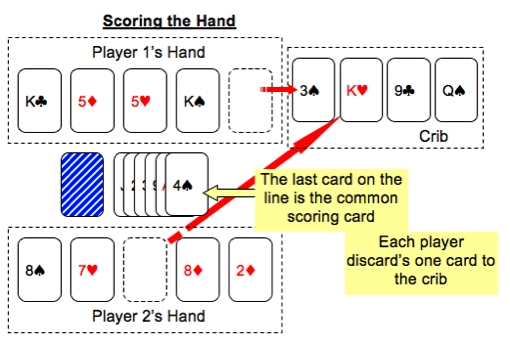


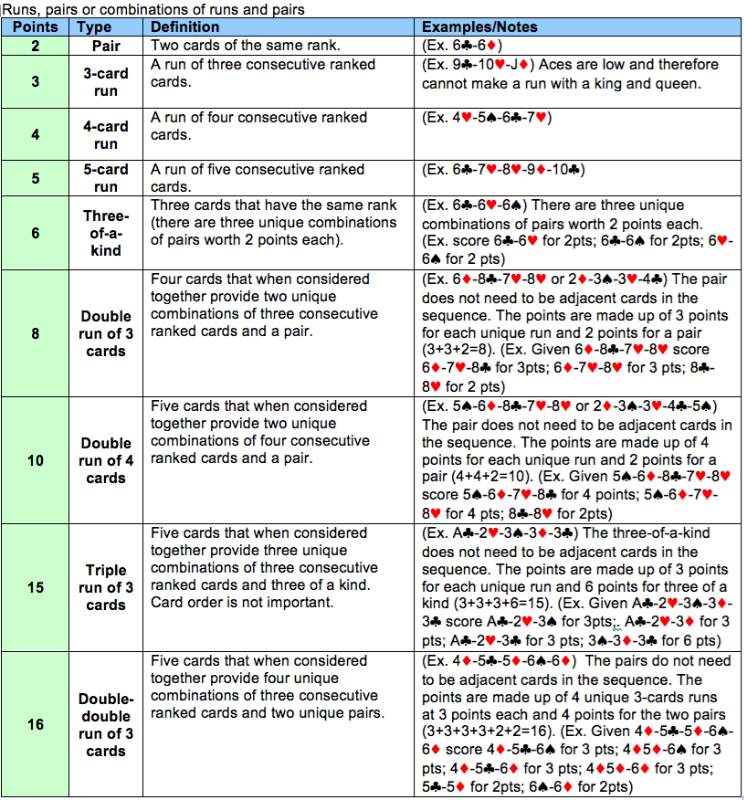

Table Talk
Prior to playing the game the players should agree upon the level of table talk allowed. For beginners table talk can be very helpful and even fun as new strategies are pointed out. For experienced players table talk could be used to mislead bringing a fun level of tension.



